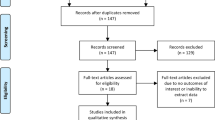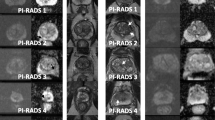Abstract
Objectives
To evaluate the recommendations for multiparametric prostate MRI (mp-MRI) interpretation introduced in the recently updated Prostate Imaging Reporting and Data System version 2 (PI-RADSv2), and investigate the impact of pathologic tumour volume on prostate cancer (PCa) detectability on mpMRI.
Methods
This was an institutional review board (IRB)-approved, retrospective study of 150 PCa patients who underwent mp-MRI before prostatectomy; 169 tumours ≥0.5-mL (any Gleason Score [GS]) and 37 tumours <0.5-mL (GS ≥4+3) identified on whole-mount pathology maps were located on mp-MRI consisting of T2-weighted imaging (T2WI), diffusion-weighted (DW)-MRI, and dynamic contrast-enhanced (DCE)-MRI. Corresponding PI-RADSv2 scores were assigned on each sequence and combined as recommended by PI-RADSv2. We calculated the proportion of PCa foci on whole-mount pathology correctly identified with PI-RADSv2 (dichotomized scores 1–3 vs. 4–5), stratified by pathologic tumour volume.
Results
PI-RADSv2 allowed correct identification of 118/125 (94 %; 95 %CI: 90–99 %) peripheral zone (PZ) and 42/44 (95 %; 95 %CI: 89–100 %) transition zone (TZ) tumours ≥0.5 mL, but only 7/27 (26 %; 95 %CI: 10–42 %) PZ and 2/10 (20 %; 95 %CI: 0–52 %) TZ tumours with a GS ≥4+3, but <0.5 mL. DCE-MRI aided detection of 4/125 PZ tumours ≥0.5 mL and 0/27 PZ tumours <0.5 mL.
Conclusions
PI-RADSv2 correctly identified 94–95 % of PCa foci ≥0.5 mL, but was limited for the assessment of GS ≥4+3 tumours ≤0.5 mL. DCE-MRI offered limited added value to T2WI+DW-MRI.
Key points
• PI-RADSv2 correctly identified 95 % of PCa foci ≥0.5 mL
• PI-RADSv2 was limited for the assessment of GS ≥4+3 tumours ≤0.5 mL
• DCE-MRI offered limited added value to T2WI+DW-MRI

Similar content being viewed by others
Abbreviations
- DCE-MRI:
-
Dynamic contrast-enhanced MRI
- DW-MRI:
-
Diffusion-weighted MRI
- GS:
-
Gleason Score
- mp-MRI:
-
Multiparametric prostate MRI
- MRI:
-
Magnetic resonance imaging
- PCa:
-
Prostate cancer
- PI-RADS:
-
Prostate Imaging Reporting and Data System
- PZ:
-
Peripheral zone
- T2WI:
-
T2-weighted images
- TZ:
-
Transition zone
References
Siegel R, Ma J, Zou Z, Jemal A (2014) Cancer statistics, 2014. CA: Cancer J Clin 64(1):9–29
Loeb S, Bjurlin MA, Nicholson J, Tammela TL, Penson DF, Carter HB, Carroll P, Etzioni R (2014) Overdiagnosis and overtreatment of prostate cancer. Eur Urol 65(6):1046–1055
Ploussard G, Epstein JI, Montironi R et al (2011) The contemporary concept of significant versus insignificant prostate cancer. Eur Urol 60(2):291–303
Polascik TJ, Passoni NM, Villers A, Choyke PL (2014) Modernizing the diagnostic and decision-making pathway for prostate cancer. Clin Cancer Res 20(24):6254–6257
Barentsz JO, Richenberg J, Clements R et al (2012) ESUR prostate MR guidelines 2012. Eur Radiol 22(4):746–757
American College of Radiology. MR Prostate Imaging Reporting and Data System version 2.0. Accessed April 2015, from http://www.acr.org/Quality-Safety/Resources/PIRADS/).
Wibmer A, Hricak H, Gondo T, Matsumoto K, Veeraraghavan H, Fehr D, et al. (2015) Haralick texture analysis of prostate MRI: utility for differentiating non-cancerous prostate from prostate cancer and differentiating prostate cancers with different Gleason scores. Eur Radiol.
Hamoen EH, de Rooij M, Witjes JA, Barentsz JO, Rovers MM (2015) Use of the Prostate Imaging Reporting and Data System (PI-RADS) for Prostate Cancer Detection with Multiparametric Magnetic Resonance Imaging: A Diagnostic Meta-analysis. Eur Urol 67(6):1112–1121
Vache T, Bratan F, Mege-Lechevallier F, Roche S, Rabilloud M, Rouviere O (2014) Characterization of prostate lesions as benign or malignant at multiparametric MR imaging: comparison of three scoring systems in patients treated with radical prostatectomy. Radiology 272(2):446–455
Rosenkrantz AB, Kim S, Lim RP et al (2013) Prostate cancer localization using multiparametric MR imaging: comparison of Prostate Imaging Reporting and Data System (PI-RADS) and Likert scales. Radiology 269(2):482–492
Vargas HA, Akin O, Shukla-Dave A, Zhang J, Zheng J, Kanao K, Goldman D, Moskowitz CS, Reuter V, Eastham J, Scardino P, Hricak H (2012) Performance Characteristics of MRI in the Evaluation of Clinically Low-Risk Prostate Cancer: A Prospective Study. Radiology 265(2):478–487
Acknowledgments
We are grateful to Mrs. Ada Muellner, MS, for her editorial assistance. The scientific guarantor of this publication is Hebert Alberto Vargas. The authors of this manuscript declare no relationships with any companies, whose products or services may be related to the subject matter of the article.
This project was supported in part by NIH grant P30 CA008748. Two of the authors (DAG, CSM) have significant statistical expertise. Institutional Review Board approval was obtained. Written informed consent was waived by the Institutional Review Board. Some study subjects or cohorts have been previously reported in [7]. Wibmer A et al. Haralick texture analysis of prostate MRI: utility for differentiating non-cancerous prostate from prostate cancer and differentiating prostate cancers with different Gleason scores. Eur Radiol. 2015 May 21. [Epub ahead of print]. Methodology: retrospective, cross-sectional study, performed at one institution.
Author information
Authors and Affiliations
Corresponding author
Additional information
H. A. Vargas and A. M. Hötker contributed equally to this work.
Rights and permissions
About this article
Cite this article
Vargas, H.A., Hötker, A.M., Goldman, D.A. et al. Updated prostate imaging reporting and data system (PIRADS v2) recommendations for the detection of clinically significant prostate cancer using multiparametric MRI: critical evaluation using whole-mount pathology as standard of reference. Eur Radiol 26, 1606–1612 (2016). https://doi.org/10.1007/s00330-015-4015-6
Received:
Revised:
Accepted:
Published:
Issue Date:
DOI: https://doi.org/10.1007/s00330-015-4015-6




